
AK-100 SERIES CARBINE NOTES
Technical Page 7:
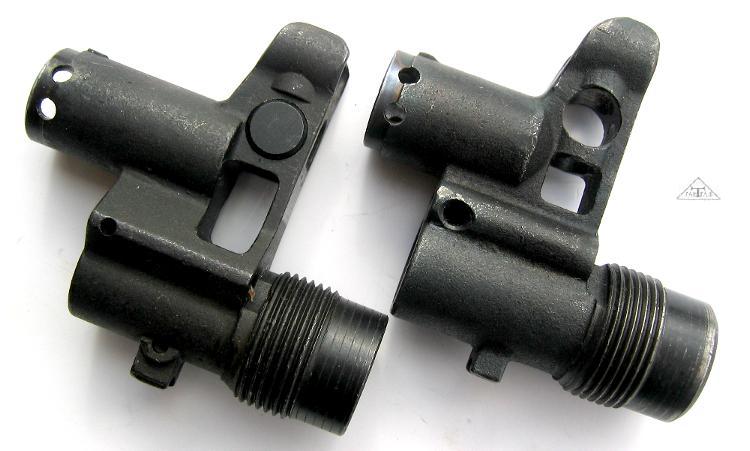
In Detail: A Close Look At Unique Russian AK-102/104/105 Features
There is currently a great deal of interest in the medium length barrel AK-100 series rifles, especially among collectors. Developed in the early 1990's, these carbine-sized rifles fill a niche between the full size AK and sub-machine guns. With a barrel length of 314mm and a folding stock, this short variation (otherwise based on AK-74M specifications) is handy to carry for personnel who require a smaller, more compact weapon.
The AK-105 is chambered in standard Russian M74 5,45x39mm, while the AK-101 is manufactured in 5,56x45mm NATO (destined for export) and the AK-104 in the trusted (and internationally friendly) Soviet M43 7,62x39mm. The AK-105 is currently seeing limited action among CIS forces.
Why is this weapon significant? Well, Russian publications state the AK-105 (5,45x39mm) was adopted by the armed forces as a replacement for the obsolete AKS-74U rifle (officially removed from manufacture for the military in 1992). The AKSU apparently suffered from a limited accuracy potential due to it's shorter 210mm barrel. As of this writing, it is uncommon to see the AK-105 rifle in the hands of anyone but specialized end users (SPETsNAZ), higher level body guards, factory representatives, and at publicly held arms demonstrations. Obviously, funding has made it impossible to currently issue as many of these small arms as might have been procured in an earlier, more generous financial era.

RUSSIAN AND BULGARIAN COMPARISONS
The AK-100 short barrel assembly is developed around a new style combination front sight base/gas block to create a single, unique combination unit. Here we show an original Russian AK-100 unit (right side) alongside the more commonly available Bulgarian version. Both are unpainted original production units, and are fully finished castings. The Russian unit does not have a windage drum installed. Note various differences, which we will discuss below.
BARREL JOURNAL NOTES
One interesting variation between the Russian (right) and Bulgarian examples concerns the barrel journal size. The Russian combination unit is made to fit the barrel step (or journal) of the front sight base, while the Bulgarian unit is made to fit the gas block journal on a regular barrel. This means the Bulgarian unit was designed to simply fit a regular AK barrel that has been shortened, while the Russian gas block/FSB is made to fit a re-contoured barrel with a smaller journal size at the gas vent.
BULGARIAN RELOCATION OF THE DETENT PIN HOUSING
Note the differences in shape and location of the detent pin housing, which holds the detent pin/detent spring and cross-pin retainer. All of these parts retain and "clock" the muzzle booster, and are located at the top right side of the barrel sleeve. The Bulgarian detent location is lower (about 10:00) and angular, while the Russian version is higher (11:00) and more rounded in shape.
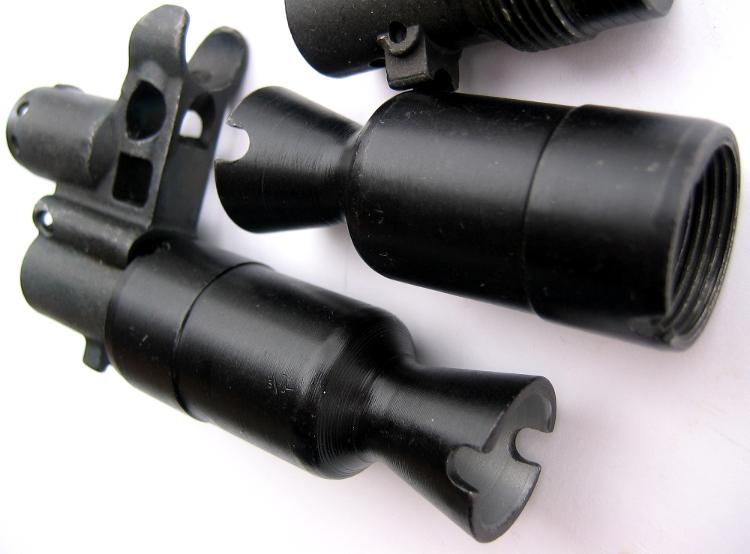
RUSSIAN MUZZLE ATTACHMENT "CLOCKS" IDENTICAL TO THE AKS-74U
The Russian boosters are indexed (see identical detent pin notch) to clock exactly like the AKSU booster. However, the Bulgarian "AK-100" unit will not properly clock either AKSU boosters or original Russian AK-100 boosters, because it has a lower detent positioning location. The Bulgarian unit was designed to use the Bulgarian-unique, square-shaped muzzle device (with internal cone hider) as used on the AR-SF series in 7,62x39mm and 5,56x45mm.
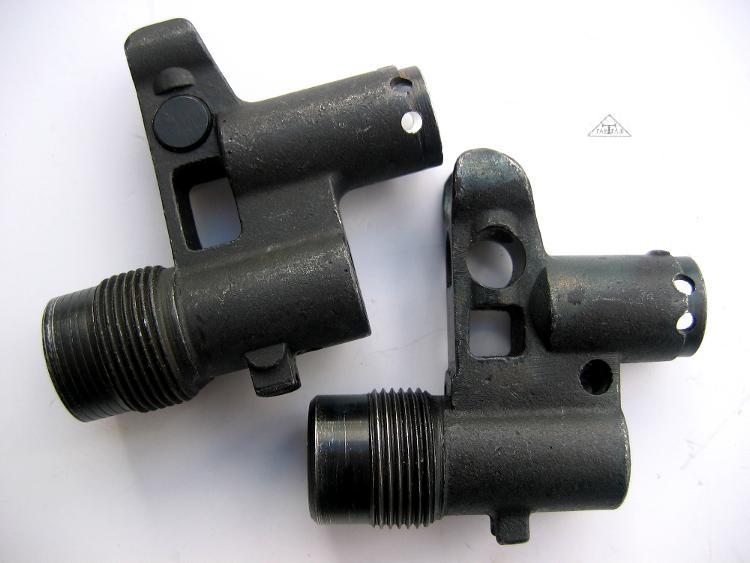
DETENT CROSS-PIN THROUGH-HOLE
This photo illustrates the differences in the location of the cross-pin that holds the detent and it's spring. The Russian unit (right) has a through-hole which is above the barrel, while the Bulgarian unit has no through-hole (due to the low location of the detent pin tube on the right side) and the pin must either be installed blind or used as a barrel pin.
SHORTER GAS CYLINDER EXTENSION FOR USE WITH A SHORTER BARREL
Also note that the Russian pattern is made to be located closer to the receiver (by about 7mm), and does not fit in the same exact location as the AK-74 gas block. Due to it's location on the barrel, the gas tube extension has been shortened a small amount in order to still use the regular AK-74 length gas tube. In the case of the Bulgarian unit, the gas tube extension is longer, since the part is made to fit the standard gas block location on the AK/AK-74. What this means is that the original Russian model carbine would have a slightly shorter barrel than the Bulgarian model. Both styles are made to use a regular, full length AK-74 style gas tube. It is quite clear the Russian AK-100 carbine has a unique barrel and was not simply designed around a cut-down AK-74 barrel. For reasons of tuning (and to meet specifications on length) it was engineered to be slightly shorter with a gas vent hole relocated rearward.
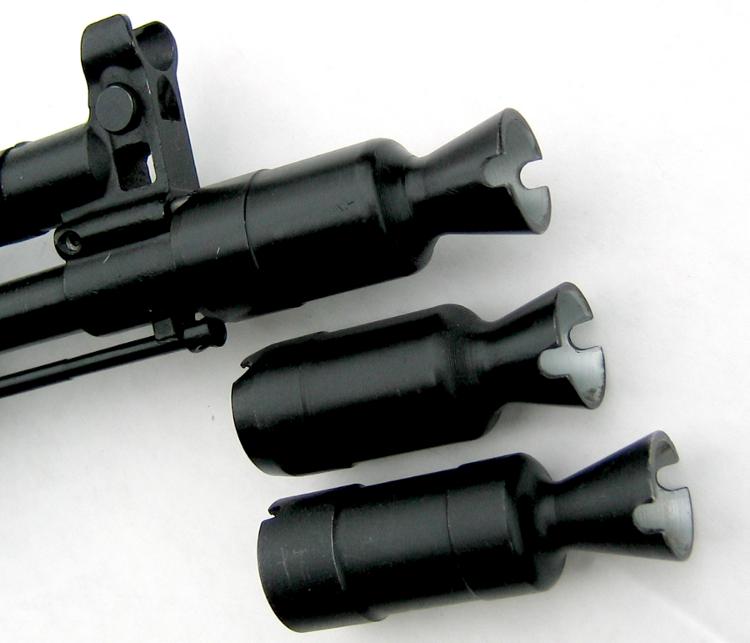
UNIQUE MUZZLE BOOSTER DESIGN
The shorter barrel (100mm shorter than the AK-74M) made it necessary to employ a muzzle booster design similar to that used with the AKS-74U. However, gas port tuning and a longer barrel (needing a shorter duration gas impulse) enabled engineers to shorten the booster of the AKSU down from 81mm overall length to about 69mm. Part of the length savings was due to a slightly smaller forward extension ("cone hider").
In this image, (top to bottom) we see a late issue Russian AK-105 (5,45mm) booster, a standard Russian AK-104 (7,62x39mm) booster (with a wider cone base and a larger rear bevel on the threaded collar area), and a late issue Russian AKSU booster with sharply shouldered edges and very little rear bevel.
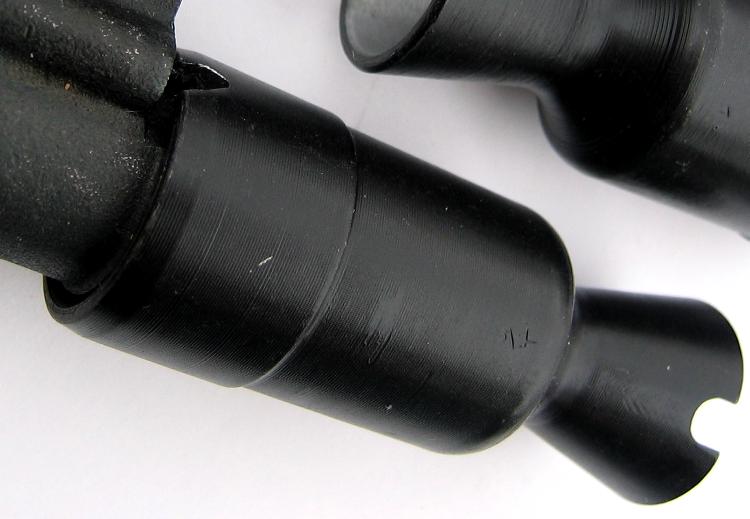
This original AK-105 booster shows a Russian proof located on the front section of the expansion chamber, right before the cone shaped hider extension. Also not the small amount of bevel on the rear of the booster. This beveling seems to vary among units, and according to when they were made.
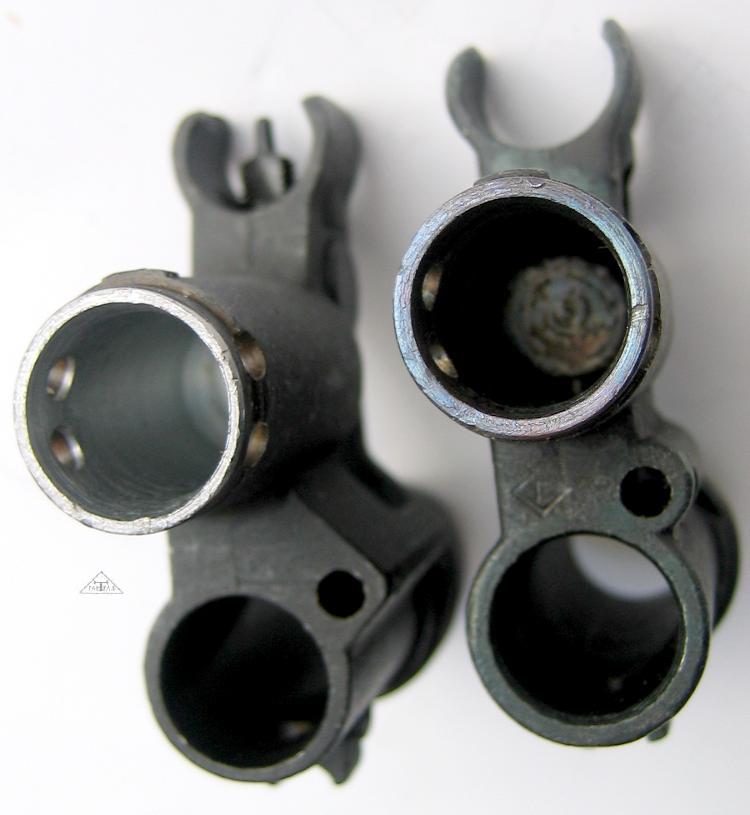
This rear view image illustrates more differences in the Russian (right) and Bulgarian (left) patterns. Note the Russian model and it's higher mounted detent tube. The Bulgarian pattern exhibits a heavier, more angular detent housing.

Back to PARTS TECHNICAL SECTION
LARGE STYLE "SIGHT EARS"
The Russian unit has the larger diameter protective sight (open ring) ears of the AKSU unit (18mm), while the Bulgarian "sight ears" are smaller and identical to those of the AK-74 (about 16mm).
As we discussed previously, the Russian unit has an internal barrel journal diameter (14.5mm) which matches the front sight bases of the AKM/AK-74. The Bulgarian model is made to fit cut-down barrels and has a larger diameter to match the gas block journals of these barrels (15mm). Note the large diamond proof on the rear of the Russian combination block. The Russian gas cylinder extension still shows a layer of brownish-yellow cosmoline.
A PERSONAL THANK YOU:
I wish to thank fellow collector and good friend R. Stott for his help on this page. Without his thoughtful assistance, I would not be able to present the information to full advantage. --Tantal

Back to PARTS TECHNICAL SECTION
